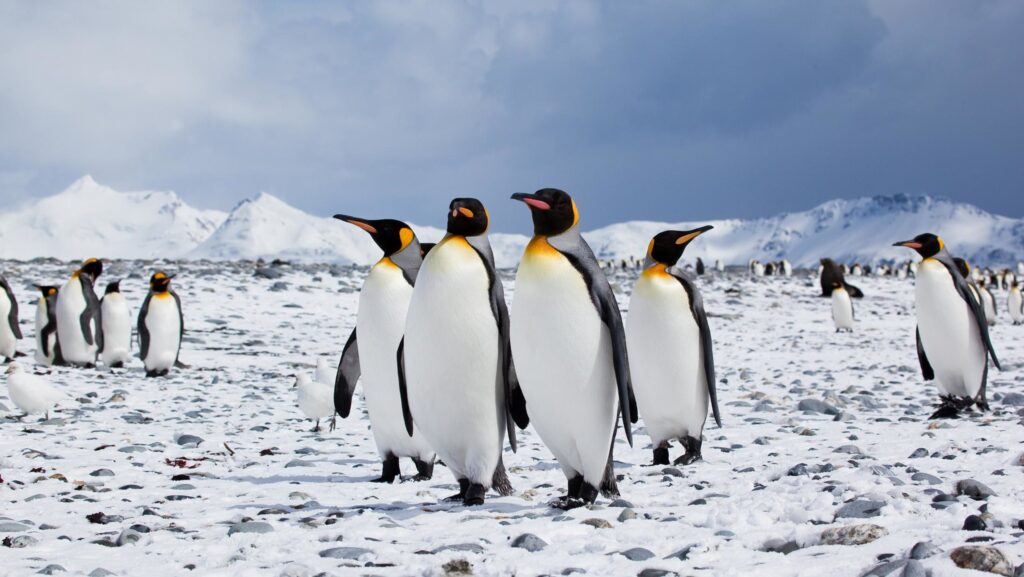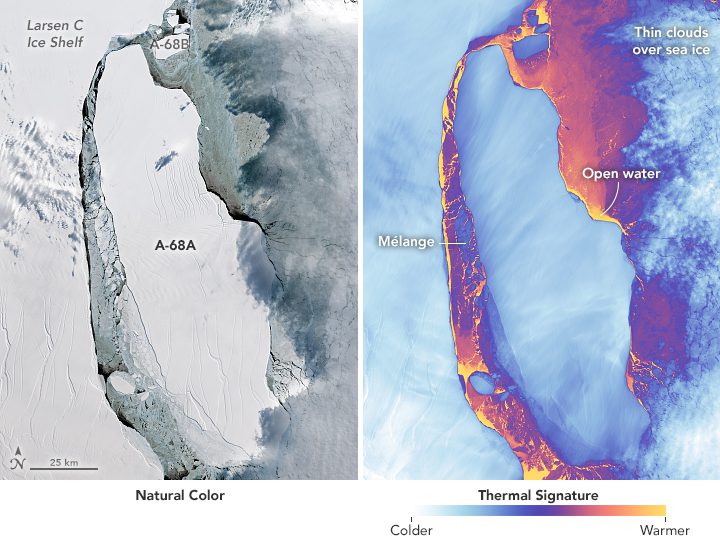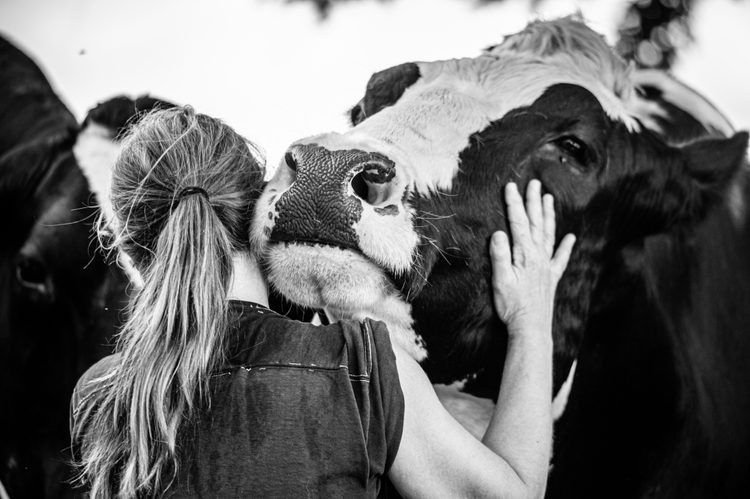


By Reynard Loki, Independent Media Institute
5 min read
In 2017, a massive iceberg 80 times the size of Manhattan calved off of Antarctica, has been moving through open water, and is now bearing down on South Georgia Island, a British Overseas Territory, threatening a biodiverse ecosystem that supports critical habitat for thousands of animals, including penguins and seals. The iceberg, known as “A68,” is one of the world’s largest—larger than South Georgia itself—and broke off the Larsen ice shelf as a result of human-caused climate change, which is driving the rapid melting of the West Antarctic ice sheet. The gargantuan iceberg, which CNN reported was less than 300 miles away from South Georgia earlier this month and traveling at 0.6 miles per hour, threatens to block seals’ and penguins’ access to their normal feeding grounds at a time of year that is critical for the growth of these colonies.
“If [the penguins] have to make massive detours around the iceberg to make the same trip they normally would, they likely won’t be able to get back in time (to feed their young),” Geraint Tarling, an ecologist at the British Antarctic Society, told CNN, adding that because the iceberg is so big, it could remain stuck on the island for years, potentially causing catastrophic damage to the area’s marine life. “When you’re talking about penguins and seals during the period that’s really crucial to them—during pup- and chick-rearing—the actual distance they have to travel to find food (fish and krill) really matters,” said Tarling. “If they have to do a big detour, it means they’re not going to get back to their young in time to prevent them starving to death in the interim.” He added: “Ecosystems can and will bounce back of course, but there’s a danger here that if this iceberg gets stuck, it could be there for 10 years. An iceberg has massive implications for where land-based predators might be able to forage.”
South Georgia and the neighboring South Sandwich Islands are a “haven for wildlife,” according to the local government, which points out that the islands are “home to about five million seals of four different species, and 65 million breeding birds of 30 different species. … The waters surrounding the islands are an important habitat for migrating whales and are host to a vast array of marine benthic fauna. They are also rich in fish species (including commercially important species) and are important for Antarctic krill populations which are a key link in the Southern Ocean food web.”

Scientists are looking to similar past events to see what might happen if the iceberg doesn’t change course, or if humans don’t intervene to rescue the animals. When the massive A38 iceberg ground on South Georgia in 2004, “countless dead penguin chicks and seal pups were found on local beaches,” reports Jonathan Amos for BBC News, noting that the region is “something of a graveyard for Antarctica’s greatest icebergs.”
If humanity fails to limit global warming to well below 2° Celsius, ideally not letting the planet’s surface temperature increase by 1.5° Celsius—the central goal of the Paris climate agreement—the region will also become a graveyard for so many species. In fact, scientists worry that human-caused climate change will devastate biodiversity not just at polar regions experiencing the rapid melting of sea ice, but across the world. A report released in 2018 by the Intergovernmental Science-Policy Platform on Biodiversity and Ecosystem Services, an intergovernmental body based in Bonn, Germany, warned that climate change could cause some wildlife populations in Africa to plummet by as much as 50 percent by the end of the century, while up to 90 percent of the Pacific Ocean’s coral reefs—which support so many other species—could undergo deadly bleaching or degrade by the year 2050.
From above, the A68 iceberg is, rather aptly, shaped like a pointing finger. The finger is pointed not only at all the species in its path of destruction on South Georgia Island, but to the one species to blame for this potential environmental calamity: humans.
- Sign the petition urging the British government to fund a scientific mission to rescue the penguins on South Georgia Island.
Cause for concern…

“The Trump administration is advancing plans to auction drilling rights in the U.S. Arctic National Wildlife Refuge before the inauguration of President-elect Joe Biden, who has vowed to block oil exploration in the rugged Alaska wilderness,” reports Jennifer A. Dlouhy for Bloomberg.
- Trump to rush drilling leases in Arctic before Biden takes over (Jennifer A. Dlouhy, Bloomberg)
- Climate damage might be Trump’s most profound legacy (Coral Davenport, The New York Times)
- Scientists watch as China’s remote glaciers melt at shocking pace (Martin Quin Pollard, Reuters)
- Jordan’s donkeys suffer from neglect in Petra amid pandemic (Charlie Faulkner and Asmahan Bkerat, Middle East Eye)
- Polish president strongly opposes animal protection bill that would ban fur breeding and exports of ritual slaughter meat (The First News)
Round of applause…

“President-elect Joe Biden is poised to embed action on climate change across the breadth of the federal government, from the departments of Agriculture to Treasury to State—expanding it beyond environmental agencies to speed U.S. efforts to mitigate global warming and to acknowledge that the problem touches many aspects of American life,” report Juliet Eilperin and Annie Linskey for the Washington Post.
- How Biden plans to amp up government’s climate change fight against climate change (Juliet Eilperin and Annie Linskey, The Washington Post)
- Biden SEC likely to push more climate, diversity disclosures (Andrew Ramonas, Bloomberg)
- Count on Biden to restore the national monuments Trump trashed (Chris D’Angelo, HuffPost)
- Biden pledges to set enforceable limits for toxic PFAS in drinking water (Scott Faber, Environmental Working Group)
- Wood buildings should be a requirement of any climate change policy (Nate Berg, Fast Company)
Parting thought…

“Every single sentient being on this world is unique, everyone has their own life with their own thoughts, with their own dreams, with their own feelings of fear and loneliness and every single beautiful being is a gift from our universe. Each of us emerges from the void precious in our nature and as human beings we are meant to be custodians of this beautiful world.” —Robbie Lockie
Earth | Food | Life (EFL) explores the critical and often interconnected issues facing the climate/environment, food/agriculture and nature/animal rights, and champions action; specifically, how responsible citizens, voters and consumers can help put society on an ethical path of sustainability that respects the rights of all species who call this planet home. EFL emphasizes the idea that everything is connected, so every decision matters.
Click here to support the work of EFL and the Independent Media Institute.
Questions, comments, suggestions, submissions? Contact EFL editor Reynard Loki at [email protected]. Follow EFL on Twitter @EarthFoodLife.